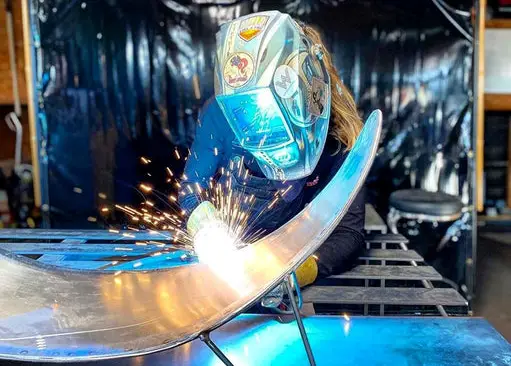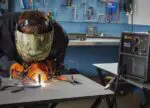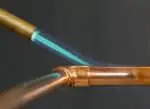Did you know that there are as many as 30 different types of welding techniques? Naturally, some of them are more popular and common than others. Stick welding, arc welding, MIG welding, and TIG welding are the most popular types.
The difficulty levels of all types of welding techniques vary. And it’s TIG welding that’s the most difficult art to master. A welder who aces TIG welding has more job opportunities.
Wondering what’s so different about TIG welding that most beginners shy away from even trying it during the initial years of their careers as professional welders?
Well, let’s just say, TIG is a true multitasking welding technique that requires the attention and precision as that of a hawk.
Not only is it different to control the quality of beads when TIG welding, but it’s also the risk of contamination that makes things even harder.
You’ll find out all the details about why TIG welding is the hardest in this guide. Dive in to understand the concept so that you too can eventually master this form of welding and earn more!
What is the hardest form of welding?
For a true beginner, all forms of welding will be hard initially. But the hardest form of welding is TIG welding. Even with a decent amount of experience, many welders take classes to get accustomed to TIG welding.
Also known as Tungsten Inert Gas Welding, TIG requires more than just one steady hand: you’ll have to actively use both your hands and your foot at the same time while TIG welding.
This hand and foot precision is what makes TIG welding difficult to learn. 99% of people are either right-handed or left-handed.
The very fact that both hands have to be equally active and stable should give you an idea about the kind of practice that TIG requires before you can even master the art of holding and using a TIG torch at weird angles.
Why is TIG Welding Hard – 4 Major Constraints You’ll Face When TIG Welding
A tungsten electrode is used in TIG welding. That’s both a boon and a curse. It’s a boon because, unlike other metals, tungsten is non-consumable. At the same time, it’s a curse that Tungsten takes no time to contaminate.
The TIG machine has a foot pedal to control the temperature. Ideally, it should make welding easier if you can control the temperature, but that’s not true.
The very fact that you get to control the temperature makes things tougher. The pressure has to be consistent. Wobbly feet will unforgivably ruin your weld in no time.
Now that you know how hard TIG welding is, let’s walk you through all the four practical constraints that you need to overcome if you want to learn how to use a TIG machine properly.
#1. TIG Welding is Awfully Slow
TIG results in the prettiest and most flawless beads – that’s true! But getting those flawless beads is a hard-earned skill.
Stick welding and MIG welding have speed working in their favor. It’s entirely the opposite for TIG Welding. The welder has to spend double, even triple, the time to TIG weld than other forms of welding require.
Patience, as you all know, is a rare virtue that doesn’t come easily. Hence, TIG is as much about mental training as it is about physical training.
#2. TIG Welding Requires Exceptional Skills
Unlike other forms of welding like MIG or stick where you can start your business in a matter of seconds, TIG takes time. It’s a slow-building process.
You’ll have to manually feed the filler material using one hand while you’ll be already (constantly) working with the TIG torch on the other hand. Utmost precision is needed because tungsten will take no time to contaminate.
Besides, while you are operating the TIG torch with your working hand, you’ll have to occasionally switch it to your other hand to weld tricky angles. This switch back and forth is a task that requires exceptional skills.
The control on the foot pedal will have to be constant all the while you’re concentrating very hard on working with both your hands.
Clearly, TIG is mind-and-body coordinating with no room for mistakes. It’s the most unforgiving form of welding. Even the slightest bit of deviation will result in inconsistent beads, ruining the entire look and finishing.
#3. Contamination is a Serious Issue
Inert gas in TIG welding does shield the metal you’re welding, but if the tip of the tungsten rod even accidentally touches the surface of the metal you’re welding for the slightest of a second, the rod will get contaminated.
Once contaminated, tungsten won’t work with the same precision at all. As a result, you’ll have to stop the welding to sharpen and decontaminate the tip again. By the time you do that, the metal you were welding will cool down.
Naturally, all the effort you’d put into making consistent beads and a strong weld will go into the ditch, and you’ll have to start from scratch.
#4. Prepping the Metal to be Welded is Crucial
MIG and stick welding are still forgiving in a lot of ways. But, as we said, TIG is hard because it doesn’t allow any room for error.
The surface of the metal has to be cleaned and scrubbed properly. There shouldn’t be even the slightest trace of paint, moisture, dust, or rust.
If you fail to prep the surface, the weld pool will contaminate no matter what.
Only pro welders that are skilled in TIG welding have this sort of patience to take care of so many things at the same time.
Why even take the initiative to learn TIG welding since it’s so tough? This query will certainly cross your mind considering you just learned that there are 30 types of welding techniques and TIG is the hardest and the most annoying one to master.
Naturally, you might be inclined to ditch this tough form of welding when there are easier options. But, in all honesty, TIG has many advantages that make it one of the most applaudable skills a welder can have.
So, for the sake of getting better and opening the can of more opportunities, you must train yourself to TIG weld.
4 Advantages of TIG Welding You Must Know
You know the constraints and difficulties already. Now, it’s about time we walk you through the advantages of TIG welding that’ll persuade you to learn this technique.
#1. It Hones Your Skills
TIG welding is hard and that’s exactly why it will make you better at what you do. Skills equal more opportunities and better pay in the welding industry.
Once you learn how to control a TIG welding machine and work without a mistake for hours (since TIG takes time), you’ll be counted amongst the best professionals in the industry.
#2. It helps you make flawless, strong welds
The foot pedal that might look like the most daunting task to master initially will, later on, be the biggest boon for welders.
Once you have learned how to control the foot pedal, you’ll be easily able to pulse it. The result would be consistently-spaced unique beads that’ll make your work even more valuable.
#3. Spatter Won’t be a Trouble Anymore
Spatter and sparks that are the major safety concerns in welding are practically non-existent in TIG welding.
Besides, you don’t really have to do the cleaning and finishing after the welding is done. Joints and welds created with TIG are already flawless.
#4. Welding Thin Metals Will Be Easy
TIG welding is one of the rare techniques that will allow you to weld thin metals while ensuring that the joints don’t turn out to be brittle at all.
FAQs
1.) What is the most difficult material to weld?
People usually think that it’s hardest to weld steel and stainless steel. That’s, however, not the case. Titanium is the hardest material to weld, steel being the easiest.
2.) What is the hardest joint to weld?
Welding isn’t always going to be comfortable. A welder has to weld joints at many odd positions. Out of the many, it’s the overhead joint that’s the hardest to weld.
It’s the hardest because:
-
-
- The vertical position is the hardest to reach.
- The welder is directly working under the shower of sparks, fumes, and molten metal.
-
3.) Is TIG or stick harder?
Hands down, TIG is the hardest form of welding. Whether it’s stick welding or MIG welding, they’re much easier and faster than TIG.
4.) What metals can TIG weld?
There are many metals that can be welded using TIG. To name a few:
-
-
- Carbon steel, alloyed steel, and low-alloy steel.
- Nickel and nickel alloys.
- Aluminum and aluminum alloys.
- Copper and copper alloys.
- Magnesium.
- Titanium.
-
TIG can be basically used to weld all non-ferrous alloys.
Concluding Thoughts:
TIG is the most difficult weld to make. It requires a lot of practice before a welder can learn how to use both hands and a foot, all at the same time, to TIG weld a metal.
Despite the tediousness, mastering how to TIG weld is a matter of prestige. Only somebody who can efficiently TIG weld for hours can be the best at all other forms of welding.
So, if you’re a beginner or even an experienced welder who has been shying away from learning how to TIG weld because it’s hard, you should learn it to get better at your job and earn more.







